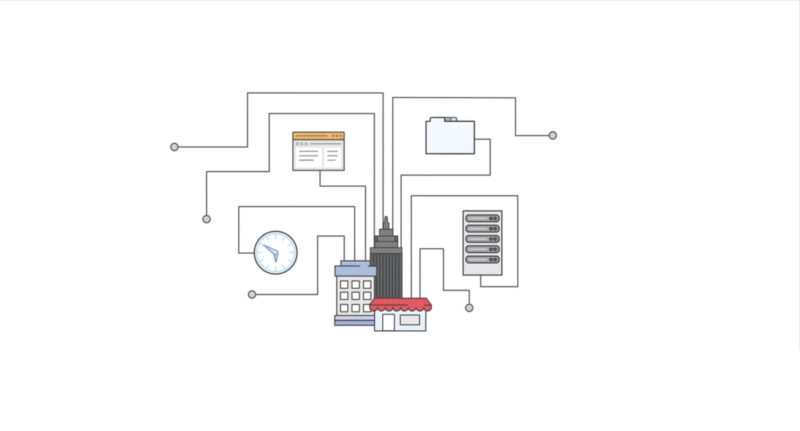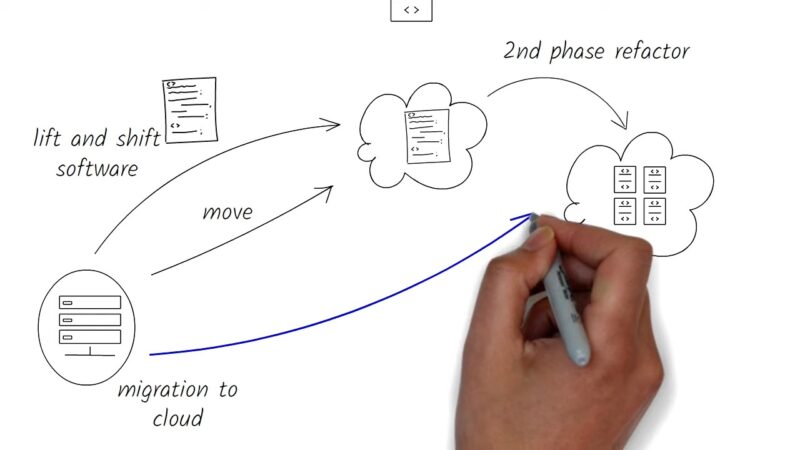Organizations are increasingly making the decision to migrate their IT operations to a cloud environment. Whether the move is driven by cost considerations, flexibility, or security reasons, transferring from an on-premises infrastructure to a cloud-based one can be a considerable undertaking.
Not only must data be transferred, but any applications and operations currently deployed in physical servers will also need to make the move. That’s where lift and shift migration comes in.
What is Lift and Shift?
Also known as “rehosting” or the “forklift approach,” lift and shift is a term used to describe the strategy of removing workloads and tasks from one storage location and placing them in another, usually cloud-based, location. The advantage of a lift and shift cloud migration is that it allows organizations to move their applications quickly and easily without having to re-architect them.
While the process is sometimes characterized as “cutting and pasting,” it requires a great deal more forethought, documentation, and planning to ensure that data sets will be matched with handling systems in the new environment and that the applications will have all the resources they need to operate effectively.
Benefits of a Lift and Shift Strategy
In addition to being rather simple to conceptualize, there are a few important advantages to using a lift and shift migration strategy.
Faster Migration
First and foremost, the lift and shift strategy is the fastest migration method for getting applications out of on-premises infrastructure and into a cloud environment. While any migration needs to be thoroughly planned and documented to avoid missing any key dependencies, the actual process of replicating workloads and migrating them into a cloud environment is relatively quick to carry out.
For organizations that can’t afford long periods of downtime during a migration, the lift and shift strategy allows them to get up and running in a new environment with minimal service disruption.
Cost-Effective

Rearchitecting applications to run natively in the cloud is not only a time-consuming process but also an expensive one. That’s because IT engineers must go through the difficult process of reverse-engineering the existing application in order to build and test a new version of it, which takes a great deal of time and expertise as well.
All of that labor can get quite expensive, especially if additional software tools and equipment need to be acquired to do the work. The lift and shift strategy may be a “quick and dirty” migration, but it can be performed relatively inexpensively, especially if the application being moved can be readily optimized to work in a new environment.
Less Resource-Intensive
Replicating an existing workload necessarily involves additional resources to facilitate the migration, but a lift and shift migration only requires enough resources to handle the replication. Any tweaking, up-versioning, or refactoring process that would involve altering, rebuilding, or recoding the application would call for quite a bit more computing and storage resources.
While this may be necessary in some cases, if that resource-intensive work will only amount to a modest improvement in performance, it’s usually not worth the effort, especially if it’s possible to optimize the application once it’s in the cloud.
Challenges of a Lift and Shift Strategy

As one might expect, lift and shift cloud migration isn’t always quite as simple as it sounds. Here are a few considerations you should take into account as you develop your cloud migration strategy.
Cloud Migration is a Process
Lift and shift migration is generally a quick and easy way to eliminate the expensive overhead costs of maintaining on-premises servers. By simply rehosting applications in a cloud environment, organizations can continue to operate with minimal service interruption and avoid the high potential costs of rebuilding or redesigning their systems.
In many cases, however, this also means that applications may not be optimized to take advantage of the new environment, which can result in companies negating some of those cost savings due to inefficiency. Sooner or later, assets that have been lifted and shifted into a new environment are going to have to be redesigned to take full advantage of the available cost-efficiencies.
While shifted applications don’t usually need to be rebuilt from the ground up, they may not perform as effectively as possible without a bit of tweaking. Fortunately, lift and shift migration makes it possible to make necessary changes over time without compromising crucial business operations.
Once everything is in the public cloud, it’s a simple matter of making minor adjustments as needed, avoiding the problem of maintaining two separate infrastructures, and putting off migration until everything is “just right.”
Custom-Built Applications Are Harder to Move

While it’s usually a simple matter to lift and shift commercial applications to the cloud, moving more complex programs that are especially resource-intensive presents much greater challenges. Since most of these programs are custom-built to address a company’s specific needs, they’re often not able to operate effectively in a typical cloud environment without modification.
They may even require the implementation of a hybrid cloud or multi-cloud deployment. For programs that perform processing-heavy big data analysis or image rendering, a complete re-architecting is often the best solution to take advantage of cloud computing’s potential.
This redesign can usually be carried out after lifting and shifting the application, but it needs to be done before the program is rolled out for use to avoid potential performance and latency issues. In addition to requiring additional time and up-front expense, redesigning applications can also potentially result in lost capabilities or vendor lock-in.
Legacy Systems Require Special Attention
Many organizations are still operating on the same IT infrastructure they initially invested in a generation ago. Years of ad hoc updates and workaround solutions can leave data environments looking like something out of a developer’s nightmares.
In many cases, companies would probably be better served by discarding their existing infrastructure and adopting cloud-based applications. They will still need to migrate their valuable data, of course, but that will be less daunting than moving outdated applications.
Sometimes, however, businesses need those legacy systems. As with custom-built systems, legacy infrastructure requires special attention and is often not well-suited to a pure lift and shift strategy.
Moving the application to the cloud is a simple matter of storage, but reconfiguring it to ensure that it runs effectively and aligns with cloud-driven datasets will take more work than a typical lift and shift migration project. Data centers can often set up hybrid cloud or multi-cloud environments that can help preserve these applications.
3 Reasons Not to Lift and Shift to the Cloud
Ultimately, a lift and shift strategy isn’t a perfect solution for everyone. Some organizations will find that it may not be right for their existing infrastructure or the immediate future of their IT plans.
Given the potentially impactful implications of such a move, it’s a good idea for companies to understand when lift and shift migration doesn’t make sense.
1. You Don’t Want Anything About Your Applications to Change
One of the difficulties of shifting legacy applications from an on-premise solution to the cloud is that cloud architecture is much different from traditional software architecture. Traditional applications tend to consist of a single, monolithic program that contains everything needed to run the application.
Cloud architecture, however, is less centralized. It breaks programs into multiple components all running on different virtual machines or containers, each one instanced from a pool of processing resources as needed. This is partly what gives the cloud its scalability and makes it so adaptable.
Lifting and shifting a traditional application into a cloud environment without any effort to re-architect the program is bound to result in an array of problems. The program may not be able to allocate processing power effectively, for instance, rendering it slow and unresponsive.
Since the program was coded for a more centralized computing architecture, it will almost certainly feature numerous inefficiencies that cause the application to draw more resources than it should. If the application is using more processing and memory in the cloud, then any cost benefits of shifting to the cloud could quickly be negated by the increased demands.
The move to the cloud should make applications easier to manage and adjust, but if most of the IT efforts go into getting the program running the way it used to, the shift may not be worth the trouble. Adding additional virtual servers to prop up the inherent inefficiencies of a legacy application will only end up raising costs and pushing aside the potential benefits of the cloud.
2. You Rely on Custom-Built Applications

While moving an “off-the-shelf” application is relatively simple (if inefficient), transitioning an application that’s designed specifically for a company’s needs is much more difficult. Legacy commercial applications have the benefit of drawing upon a body of knowledge.
No matter which programs a company is running, chances are good that other companies have made a similar transition. Often with guidance provided by third parties familiar with the software, such as data centers or the software providers themselves, the move can be made seamlessly.
However, in the case of custom-built applications, using a lift-and-shift approach is much more challenging. The program may not be able to run outside of its current infrastructure, forcing IT personnel to develop extensive workarounds just to get the application online, much less working effectively.
Without rebuilding the program from the ground up, it may not run as effectively in a cloud environment as it does using its original, on-premise hardware. Worse, it may create an array of new problems and errors that IT experts will spend months cataloging, diagnosing, and resolving.
While this doesn’t mean custom-designed applications should never be moved to the cloud, a true lift-and-shift approach may not be possible without significant effort. Given that lift and shift are supposed to provide an easy answer to cloud migration, companies may find that it’s better to simply build an entirely new, cloud-based solution from the ground up or consider colocation services rather than expend the resources required to patch together fixes for a customized legacy program.
3. You Don’t Want to Rethink Your IT Department

Transitioning IT infrastructure into a cloud environment is the perfect opportunity to rethink the role of IT personnel in an organization. With the enhanced reliability of cloud-based services, IT professionals can spend less time troubleshooting infrastructure and more time innovating new solutions that help drive business growth.
Traditional IT teams are often very siloed, with some handling a development role and others focusing on day-to-day operations. A shift to the cloud can break down these barriers and unleash the creative potential of IT specialists.
But all of those changes will be for nothing if a lift and shift strategy doesn’t embrace the potential of cloud architecture. While IT personnel may spend time learning about how to implement new cloud-based solutions, such as hybrid cloud or multi-cloud architecture, they’ll likely be disappointed and frustrated if they end up spending all of their time propping up a legacy application in a cloud environment.
The shift to the cloud should create the opportunity to do things differently, not simply provide a reason to discard outdated IT equipment. If an organization isn’t ready to radically rethink its approach to IT practices, then moving to the cloud makes little sense.
While lifting and shifting an application to the cloud may provide some savings in terms of overhead, the majority of that investment will be wasted unless IT personnel are allowed to rethink how the company’s network can be deployed to promote business success. This, of course, means making some tough choices and taking a few risks.
If a company isn’t prepared to take that step with its legacy architecture, it probably isn’t ready to make the transition to the public cloud or implement a hybrid cloud or multi-cloud architecture. While lift and shift strategies can help an organization keep its IT operations running smoothly as they transition to the cloud, the process doesn’t make sense for everyone.
By understanding the benefits and drawbacks of lift and shift migration, companies can determine whether or not they should dedicate the time, effort, and expense to relocating their workloads directly into a cloud environment.
FAQ
What is the difference between a carrier-neutral data center and a carrier-specific data center?
A carrier-neutral data center allows customers to choose from multiple internet service providers (ISPs) for connectivity, while a carrier-specific data center is tied to a single ISP, limiting flexibility and choice.
How does a carrier-neutral data center enhance cloud connectivity?
Carrier-neutral data centers often have direct connections to multiple cloud providers, allowing for faster, more reliable, and secure cloud access, and optimizing hybrid and multi-cloud strategies.
Is there a difference in the physical infrastructure of carrier-neutral and carrier-specific data centers?
While the core physical infrastructure might be similar, carrier-neutral data centers are designed to accommodate and manage connections from multiple ISPs, ensuring versatility and scalability.
Can I switch ISPs within a carrier-neutral data center without moving my servers?
Yes, one of the advantages of a carrier-neutral facility is the ability to switch ISPs without physically relocating your servers, ensuring minimal disruption.
Do carrier-neutral data centers offer better cybersecurity measures?
While security depends on the specific facility, carrier-neutral data centers often provide enhanced security due to their connections with multiple ISPs, allowing for better DDoS mitigation and redundancy.
Final Words
In the evolving digital landscape, flexibility, reliability, and cost-effectiveness are paramount. Carrier-neutral data centers embody these principles, offering organizations the freedom to choose, adapt, and grow.
As businesses continue to embrace digital transformation, the choice of a carrier-neutral facility becomes not just a preference, but a strategic necessity.
Related Posts:
- Understanding Industrial Accidents and How Claims Work
- Cyber Insurance for Schools - Understanding the Essentials
- Why TikTok Likes Matter: Understanding Social Proof…
- Enterprise vs Edge Data Center: Which Is Right for You
- Tips for Picking the Right Camping Subscription Box for You
- How to Choose the Right Software: Why Comparisons…








